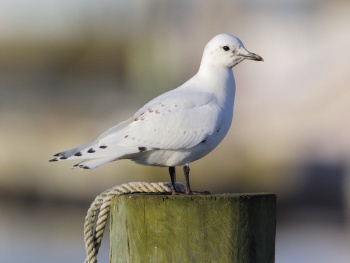(→Taxonomy: Update link) |
(References updated) |
||
| Line 34: | Line 34: | ||
'''Call''': a harsh ''eeeer''. | '''Call''': a harsh ''eeeer''. | ||
==References== | ==References== | ||
| − | #{{Ref- | + | #{{Ref-Clements6thAug14}}#{{Ref-HBWVol3}}#[http://www.absoluteastronomy.com/topics/Ivory_Gull Absolute Astronomy] |
#[http://en.wikipedia.org/wiki/Ivory_Gull Wikipedia] | #[http://en.wikipedia.org/wiki/Ivory_Gull Wikipedia] | ||
{{ref}} | {{ref}} | ||
Revision as of 20:10, 13 December 2014
- Pagophila eburnea
Identification
L. 43 cm (17 in)
Adult
- Completely white plumage
- Thick blue bill with yellow tip
- Dark eye
- Black legs
Immature
These gulls take 2 years to reach maturity
- Dusky face
- Variable amounts of black flecking in wings and tail
Distribution
Found in Arctic seas and pack ice. Breeding range from northern Siberia (New Siberian Islands, Severnaya Zemlya, Novaya Zemlya and Franz Josef Land) west to Svalbard, Greenland and northern Canada (northern Baffin Island and Queen Elizabeth Islands).
Spends most of the year along the ice edge. In winter concentrations of this species occur in Labrador Sea along the ice edge of Davis Strait. Some also winter in Bering Sea.
Some birds reach northern Europe and the north of the US in winter.
Population status poorly known as the status in northern Siberia is largely undocumented. Greenland may hold 350 to 1350 pairs, the eastern Canadian Arctic as many as 1500 pairs. Most colonies in Svalbard have declined or disappeared. However, it is unclear whether this reflects a widespread population decline, or a shift in colony sites.
Taxonomy
This is a monotypic species[1].
Habitat
Arctic coasts, cliffs, high arctic tundra, harbours, rocky coasts and ice pack.
Behaviour
Breeding
Short breeding season from late June to August. Does not breed when food conditions are bad. Breeds in loose colonies of 5 to 60 pairs, sometimes more; rarely solitary. The 2 olive eggs are laid in a ground nest lined with moss, lichens or seaweed. The nest is placed on a bare, snow-free rock behind some shelter.
Diet
Includes fish and crustaceans; they also scavenge remains of seals, porpoises etc left by predators such as polar bears. Does also take bear and seal excrement.
Movements
Spends all year along the ice edge. Disperses in summer even north of breeding range. Outside breeding season still along ice edge and only occasionally further south.
Vocalisation
Call: a harsh eeeer.
References
- Clements, J. F., T. S. Schulenberg, M. J. Iliff, D. Roberson, T. A. Fredericks, B. L. Sullivan, and C. L. Wood. 2014. The eBird/Clements checklist of birds of the world: Version 6.9., with updates to August 2014. Downloaded from http://www.birds.cornell.edu/clementschecklist/download/
- Del Hoyo, J, A Elliot, and J Sargatal, eds. 1996. Handbook of the Birds of the World. Volume 3: Hoatzin to Auks. Barcelona: Lynx Edicions. ISBN 978-8487334207
- Absolute Astronomy
- Wikipedia
Recommended Citation
- BirdForum Opus contributors. (2024) Ivory Gull. In: BirdForum, the forum for wild birds and birding. Retrieved 19 April 2024 from https://www.birdforum.net/opus/Ivory_Gull






